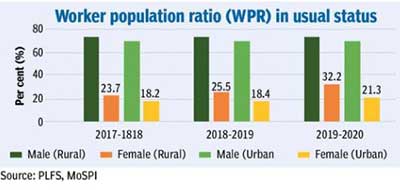Relevance: GS-2: Issues relating to the development and management of Social Sector/Services relating to Health, Education, Human Resources.
Relevance: GS-3: Inclusive growth and issues arising from it.
Key Phrases: Global Gender Gap, PLFS, CMIE, Unemployment, labour force participation rate, NSO, domestic duties, cultural norms and patriarchal culture, right to rest, right to disconnect.
Why in News?
- India slipped 28 places from 112 to 140 in the World Economic Forum’s Global Gender Gap Report 2021. The pandemic year resulted in India’s gender gap closing window widening by 4.3 percentage points. The key and persistent characteristic of the increasing gender gap is the plunge in economic opportunities for Indian women leading to their declining participation in the formal workforce.
Key Highlights:
- During this time, the gender gap widened by 3 per cent due to declining participation of women in the labour force. Women have been disproportionately affected by unemployment during the pandemic as there is a high percentage of women in the hospitality industry which was severely impacted.
- In Q4FY21, as per the Periodic Labour Force Survey (PLFS), unemployment among women in urban areas was 3.2 per cent more than men, and more so among the young workforce (15-29 years), where one in four women in the labour force has been unable to find a job. It is no surprise for all quarters since 2018, unemployment for women in urban areas has remained high compared to men (Fig below).

- Unemployment data by the Centre for Monitoring Indian Economy (CMIE) shows average unemployment for rural areas stood at 9.2 per cent (5.5 per cent-January 2022) and urban areas at 7.5 per cent (8.3 per cent-January 2022) for February 2022. Unemployment rose sharply for rural areas than urban areas, thus reversing the earlier trend.
- Annual PLFS (July 2019-June 2020) shows unemployment for women declined marginally (4.2 per cent-2020 vs 5.1 per cent-2019). Low economic growth and high unemployment move in tandem. For FY2019-20, GDP grew by just 3.7 per cent, while unemployment shows a decline. One of the reasons for different trajectory could be that primary sector (employs 42.6 per cent of labour force) grew 4.3 per cent, and tertiary sector (employs 32.3 per cent of labour force) rose 7.2 per cent, as per World Bank data.
- Women’s labour force participation rate (LFPR) (20 per cent) is considerably low compared to men (56 per cent) as per annual PLFS (current weekly status) 2019-20. LFPR denotes total of employed and unemployed as a percentage of the population. LFPR (2019-20) stands at 38.3 per cent (ILO estimate — 46.2 per cent), which is low for India. Among emerging economies, LFPR stands for China (66.8 per cent), Indonesia (66.4 per cent), Brazil (59.2 per cent), Chile (57.3 per cent) and Mexico (56.4 per cent) in 2020.
- This depicts a significant proportion of people are not even seeking jobs in India and unemployment rate shouldn’t be the only yardstick to track the labour market. It should be complemented by an employment rate which depicts the proportion of a country’s population that is employed.
- As per PLFS and NSO data, women formed only 28.7 per cent (rural — 32.2 per cent, urban — 21.3 per cent) of the Worker Population Ratio, with a decline of 3 percentage points for rural women and rise of 1.8 percentage points for urban women in nine years. World average for employment ratio (females) stood at 44.7 per cent and for China (58.1 per cent), Indonesia (52.0 per cent) and Brazil (47.3 per cent) in 2019.

Reasons for low participation of women:
- In labour surveys, many women respondents report as being occupied in domestic duties (proportion of men doing household work is negligible) which constitutes unpaid work. An increase in employment in agriculture for rural women could be distress driven (disguised unemployment) and not necessarily shows an improvement in employment for rural women unlike men.
- Low absorption of Indian women in workforce could be attributed to lack of jobs (manufacturing not being labour intensive), dearth of time due to domestic chores, cultural norms and patriarchal culture.
How to improve women participation in economy?
- Employment levels can improve in India by two ways particularly — pickup in private investment and improvement in work policies.
- As per a study demand-led growth must prioritise investment over consumption. Gross fixed capital formation declined by 10.4 per cent (2021 vs 2020). Contribution of private investment (as percentage of GDP) rose only marginally (11.2 per cent — 2012 to 14.6 per cent — 2020).
- It is a vicious circle of joblessness-less discretionary spending-weak demand-less profits-low investment, thus shrinking the lower middle-class. Alternative jobs in industry and services need to rise at a fast pace and jobs should focus on providing decent wages, job security, reasonable work hours and insurance.
- India’s unemployment problem is exacerbated due to absence of
women (missing women) in the labour force. India needs to adopt innovate
work practices followed world-wide like
- Flexible work schedule
- Strict rules for work-life balance
- Gender equal policies (maternal and paternal leave)
- Affordable childcare,
- Location flexibility, gender
- Balance at workplaces and an option for four-day workweeks/five-hour work per day for those who are unable to work full time.
- The above measures will help to retain female talent and increase their participation considerably. Portugal has passed a law (November 2021) which makes it illegal for bosses to contact employees (through text/email) outside work hours and is part of new laws dubbed as “right to rest”. A “right to disconnect” law has been introduced in countries like France and Spain.
Way Forward:
- Women are going to play a crucial part in shaping India’s growth story. It is important to create an inclusive environment in which women can thrive and put their best foot forward. Concerted effort of policymakers is needed, and they need to ask themselves on timely basis — are we doing enough to change the stereotypes and bring more women in labour force? If India wants to reap the gains of its demographic dividend, it cannot miss out on its women workforce.
Source: The Hindu BL
Mains Question:
Q. “If India wants to reap the gains of its demographic dividend, it cannot miss out on its women workforce.” Critically analyse the statement.







